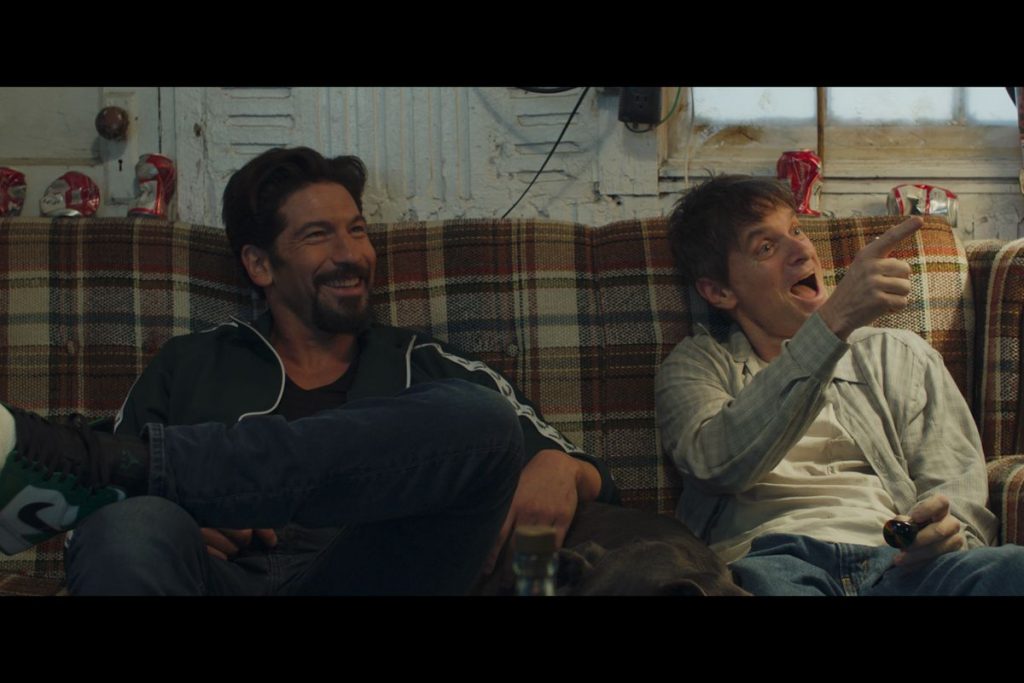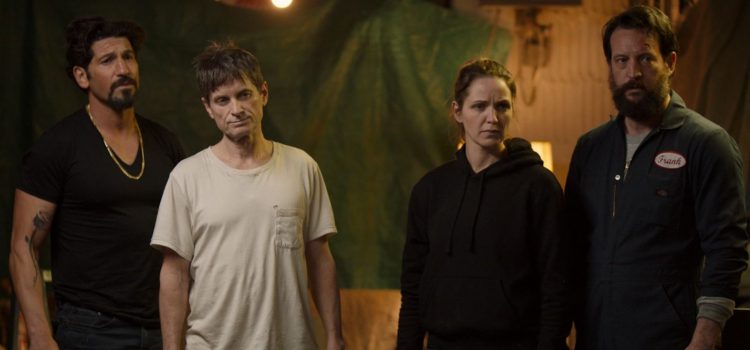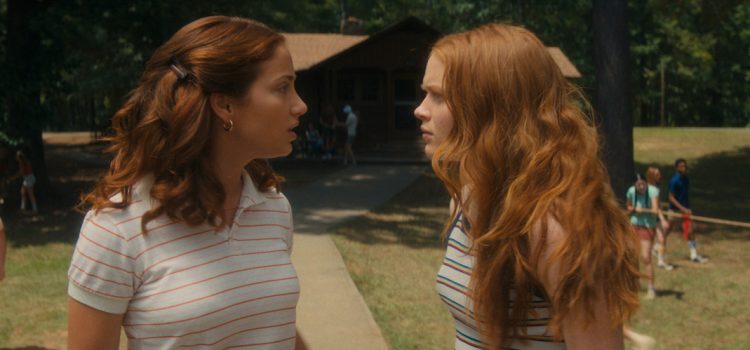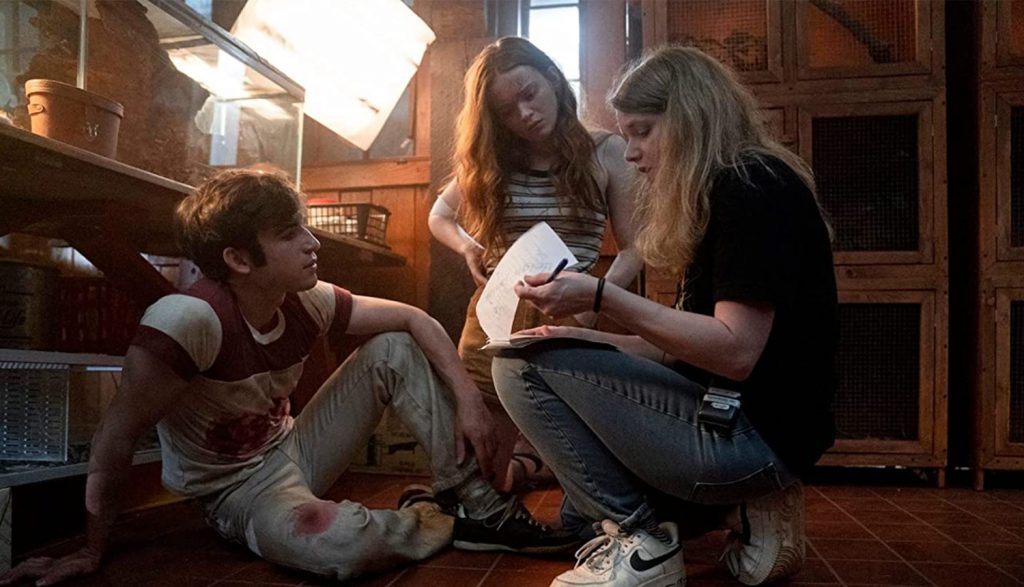By Lynn Venhaus
Tough blue-collar guys hardened by harsh winters, bleak childhoods, dead-end adult lives, and rigid views on masculinity are the central figures in “Small Engine Repair,” an intense and powerful drama with crackling flashes of comedy that is set in Manchester, N.H.
The three rough-hewn childhood friends Frankie Romanoski (John Pollono), Terrance Swaino (Jon Bernthal) and Patrick “Packie” Hanrahan (Shea Whigham) needle each other with insults but have a deep love for each other. That bond of brotherhood is tested numerous times – as they drink too much, get into fights because of their hair-trigger tempers and cope with unfulfilled lives. Frank is clearly the leader, and is a recovering alcoholic.
They have one thing they can agree on, besides the Boston Red Sox — their tender concern for Frank’s daughter, Crystal, now 17. Fiercely protective, their loyalty comes into question during an out-of-control evening based on Pollono’s 2011 award-winning play.
At first glance, one may find John Pollono’s characters drawn in broad strokes, but reserve judgment because layers will be revealed, subtly and perceptively, as the bigger picture on societal roles, class struggle and modern technology emerges.
Ten years after his explosive 70-minute one-act play hit Los Angeles audiences hard with a sledgehammer, Pollono has adapted his edgy pitch-black piece for film, expanding the landscape and adding two female performers instead of just alluding to them in dialogue. The movie, with flashbacks, runs 1 hour and 43 minutes.
Ciara Bravo, a young actress known for TV shows who starred opposite Tom Holland in “Cherry,” excels as the feisty teenage daughter Crystal. She’s a senior in high school who yearns for bigger things, like going to college and becoming somebody. Raised basically by her single dad, mechanic Frank, she considers Swaino and Packie her family.
Jordana Spiro is in the brief but pivotal role as her mostly absent mom Karen Delgado. She became pregnant as a high school junior, and eventually left the area. Her troubled relationship with Frank is complicated and she pushes his buttons. Spiro nails this woman whose life didn’t turn out as she planned.
Ultimately, this brilliantly constructed work will show how substantive it is, but as this unsettling tale unfolds, it’s not that black-and-white. Pollono, who also directed and reprises his role as Frankie, grew up in New Hampshire, and knows this grimy world. He understands about shared histories and love-hate relationships with your coarse working-class guy pals.
Actor Jon Bernthal originated the role of ladies’ man Swaino on the L.A. stage and serves as a producer. He was unable to appear in the 2013 off-Broadway production because of his burgeoning acting career in film and television. He fits Swaino to a T, inhabiting this crude, vain and unrefined guy who is too quick to react and stuck in a warehouse job. But he is sincere in his love for Crystal.
He and Pollono carry their chemistry, first exhibited in the Los Angeles production that won every award possible, over to the screen. They easily convey a longtime friendship, along with the biggest surprise – character actor Shea Wigham’s Patrick “Packie” Hanrahan.
Wigham is a revelation as stuck-in-a-rut Packie, a smart man whose technical prowess and knowledge of social networking will come into play. But he’s a serious case of arrested development, living in his grandmother’s basement, inept with women, and invasive with personal questions.
The trio don’t seem to be aware of what boundaries are, let alone have filters when they are together. Their jabs at each other cut too deep sometimes and their locker room talk gets repetitive. Yet the actors keep up a frantic pace of macho sex talk and putting each other down at every opportunity.
After a tiff, the men reunite at Frank’s urging to hang out one evening at his small engine repair garage. Only he has an ulterior motive bringing them back together for top-shelf Scotch whiskey and steaks.
Frank has asked arrogant frat boy Chad Walker (Spencer House), his drug dealer, to stop by with “Molly,” which is another name for the synthetic stimulant and hallucinogen Ecstasy (MDMA).
As they knock back shots with the technically savvy Millennial, who reeks of privilege, are they really all that different? Chad has a callous disregard for women as sex objects and is casually dismissive of others ‘not in his league.’ House displays the entitlement of a kid whose big-deal attorney father has handed him everything in life accept the lesson that actions have consequences.
One can’t divulge too much of the plot, but it’s driven by family ties and the intangible bonds of lifelong friendships. If comparing to other works, think David Mamet – and even the characters satirized by Saturday Night Live in the ‘wicked-funny’ Boston sketches. For those who watched “Mare of Easttown,” it has an uncanny resemblance to that clannish Pennsylvania enclave depicted in the HBO mini-series.
Pollono wrote the screenplay to the 2017 movie “Stronger,” which tells of Jeff Bauman’s struggle to walk after the Boston Marathon bombing, another lived-in cadre of characters steeped in their New England environment.
He demonstrates a flair for crafting real-world characters and is a strong Frankie, who tries to take care of everybody but can’t manage his anger issues.
This is a fierce suspenseful production that is unapologetic in its politically incorrectness. It features bursts of ugly violence, a torrent of expletives, and with its vulgarities, earned every bit of its R rating. It is not an easy watch.

However, Pollono’s sharp observations on the narrow lanes still in place today in society – 10 years after its stage debut – gives one pause. Dynamic ensemble work makes this a drama whose impact will linger.
“Small Engine Repair” is a 2021 comedy-drama that is directed by John Pollono, who also stars, along with Jon Bernthal, Shea Wigham, Ciara Bravo, Spencer House and Jordan Spiro. It is rated R for pervasive language, crude sexual content, strong violence, a sexual assault, and drug use and runs 1 hour, 43 minutes. It opens in theaters on Sept. 10. Lynn’s Grade: B+.

Lynn (Zipfel) Venhaus has had a continuous byline in St. Louis metro region publications since 1978. She writes features and news for Belleville News-Democrat and contributes to St. Louis magazine and other publications.
She is a Rotten Tomatoes-approved film critic, currently reviews films for Webster-Kirkwood Times and KTRS Radio, covers entertainment for PopLifeSTL.com and co-hosts podcast PopLifeSTL.com…Presents.
She is a member of Critics Choice Association, where she serves on the women’s and marketing committees; Alliance of Women Film Journalists; and on the board of the St. Louis Film Critics Association. She is a founding and board member of the St. Louis Theater Circle.
She is retired from teaching journalism/media as an adjunct college instructor.



